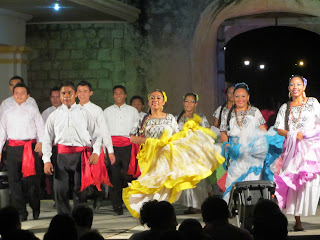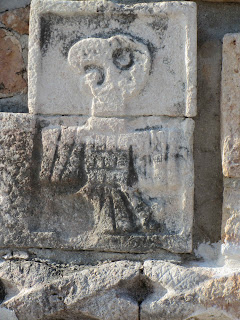VIVA MEXICO!!!
VINCENT COMES TO TOWN
October 1st seemed like a good day to begin our Latin American adventures and Wil and Hilary obviously felt that a penitent climb past the stations of the cross to the shrine on the hill behind Ajicic would set the tone for our visit.
A wonderful view over Lake Chapala was the reward for the stiff hike.
ABOVE LAKE CHAPALA
A tour of the village was followed by a visit to the bull ring where a display of horsemanship was taking place. A waiter appeared bearing a tray with glasses, tequila and coca cola - a gift from one of the Charros riders in the ring below.
CHARROS
The family sitting beside us poured the drinks and Francisco, in his splendid outfit, quickly became Vincent's new best friend!
The house at Ajijic is lovely - bright, spacious and opening on to an azure pool surrounded by shrubs, trees and creepers. Wil has worked hard in the garden and he and Hilary seem to have discovered their perfect home in the sun. They have a very comfortable, busy and creative life here in Mexico and have made friends among the large expat population.
AJIJIC
Wil continues to put on a barbeque with just as much flair as he did back in Fremantle with added Mexican touches of lime and chili and we have been treated to some delicious meals served on colourful local pottery.
WIL & HILARY'S GARDEN, AJIJIC
Humming birds skim over the pool, kiskadees and vermillion flycatchers keep us company over an outdoor breakfast.
KISKADEE
VERMILLION FLY CATCHER
In the evening Chapala is full of holiday crowds with people flocking into the town to celebrate the fiesta of St Francisco. We enjoyed dinner at a restaurant overlooking the lake and ordered a traditional dish of prawns and fish called molcojate after the bowl it is served in. This was followed by folkloric dancing outside the church and, later, fireworks by which time we had retired home to sleep. Each morning around 5am, fireworks wake the village but no one seems to know why.
FOLK DANCES FROM JALISCO
AND FROM OAXACA
Shopping for household goods can be fascinating - our first visit was to a veritable Aladdin's cave where we found a Catrina figure for Cara. The Calavera de Catrina was the creation of Jose Guadaloupe Posada and various representations have become an important symbol of the Day of the Dead celebrations on November 2nd. She is modelled on the fashionable ladies of Mexican society but is in fact a reincarnation of Mictcacihualt the Aztec goddess of the underworld.
CATRINA
TV AQUARIUM
Just one of the many amazing shops selling hand painted pottery
Home fittings and furnishings , Mexican style. The Frida Kahlo was just one of many designs for dining room sets - for more see www.magiaymueble.com
On the far side of Lake Chapala and high in the mountains lies the small scenic village of Mazamitla. In the market, after a walk around the colourful streets, we enjoyed our first but probably not our last taco - delicious with a cold Mexican beer
THE CHURCH IN MAZAMITLA
CHILLI STALL
SCULPTURE OUTSIDE HOSPICIO CABANAS
BY ALEJANDRO COLUNGA
BIRTHDAY DINNER
Our visit to Ajijic ended the day after my birthday, celebrated with another wonderful barbeque followed by my old favourite flan with local berries which grow well in the mild climate around the lake
YUCATAN
THE CALLES OF CAMPECHE
On October 8th we arrived at the town of Campeche in Yucatan. The small historic centre is a Unesco listed site and it is delightful to walk along the streets lined by brightly coloured buildings of mostly one or two stories. It is surrounded by a massive 16th century wall punctuated by nine baluartes or bastions and the sea originally came up to the Puerto del Mar (sea gate).
CHURCH OF ST FRANCISQUITO
INTERIOR
A FOLKLORIC PERFORMANCE
EDZNE
JAGUAR THRONE
The surrounding jungle is full of birds and further south jaguars, the most venerated and represented animal in Mayan myth and sculpture, is found. The Mayan name was Balam and this was often incorporated in the name of rulers who associated jaguars with night vision and hunting ability.
SOCIAL FLYCATCHER
AMERICAN BLACK VULTURE AT EDZNE
ITZANNAAJ, THE CREATOR
An overnight stay at the very comfortable Hacienda Uxmal gave us the chance to attend the sound and light performance. Our first view of the immense pyramid was therefore by night. Regretably, the production was rather akin to a gothic horror movie with flashing lights, loud and dramatic music and much recorded wailing and chanting which was apparently a cry to the god of water, Chac to send rain.
CHAC MOOL
UXMAL
The buildings were plastered and painted at the height of their prosperity. An adequate supply of waterwas the basis for the success of Mayan civilization and much effort went into ensuring this. The Yucatan peninsula is a flat limestone plateau of varying thickness and there are no rivers or lakes above ground. Underground rivers sometimes breach the surface as caves or cenotes and it was believed that the rain god Chac resided in such places. Sacrifices of valuable items and sometimes young girls were made in the hope that the person would return to deliver a message about the success of the harvest.
THE BALL COURT
The ball court was used for ceremonial games between two teams. A rubber ball was used and passed by knees, shoulders and elbows. The aim was to propel it through a stone hoop which still remains in position. It is said that either the winners or losers were sacrificed following the game.
A BALL GAME PLAYER
IGUANA AT UXMAL
The Maya were able to develop a complex urban society by around 1000AD due to the cultivation and develpment of improved strains of maize. They domesticated turkeys and small dogs which were eaten during certain rituals. Crops included cotton, cacao, the beans of which were often used as money and tobacco which was used in rituals and as a medicine.
CHAC SCUPTURE AT CORNERS OF THE PALACE
Significant trading routes existed over a wide area between the city states. Many commodities were traded including alabaster from Honduras, turquoise from the SW of the USA and vessels from Teotihuacan
INTRICATELY CARVED FRIEZE UXMAL
PLUMED SERPENT, UXMAL
THE VICTOR
AND THE VANQUISHED
BAT FALCON
BIRD REPRESENTATION
POTTERY SHOWING TRACES OF COLOUR
WARRIORS
Our small hotel in Merida, Marionetas provided a tranquil haven in what proved to be a hot, noisy city with little to recommend it except proximity to a number of important historical sites. It proved to be much better to stay overnight at the sites in order to visit in the early morning before the heat and crowds.
On our last afternoon, a little jewellry shopping seemed in order!
MEXICAN SILVER
The final Mayan site, Chichen Itza, is also one of the most famous and most visited. Again, we stayed at a hotel near the entrance and were able to spend a few hours wandering through the impressive ruins before the tour buses arrived. Although extensive in area, the site seemed less impressive than Uxmal however the carving and detail on the many friezes was outstanding. One of the main group of building, a huge ball court was closed for preservation work but among the other buildings were the Observatory and the platform of the skulls where trophies from war and sacrifice were displayed vertically and an extensive frieze depicted rows of skulls.
CENOTE SAGRADO
The cenote at Chichen Itza was the main source of water and was regarded as sacred. Sacrifices were made to Chac, the water god, to ensure that rain would fall to water the maize and other crops. These took the form of valuable belongings and sometimes young men and women
A long bus ride, during which we watched the film Amazing Grace about the life of William Wilberforce who fought in Parliament for the abolition of the slave trade, finally brought us to Cancun which had been described to us as the Las Vegas of Mexico. The hotel strip stretches for 22km and each hotel is bigger than the one before. Ours was a mind boggling collection of concrete and glass pyramids. During the night, a violent storm came in from the Caribbean and when we awoke in the morning we found that the force of the wind had driven the rain under the sliding doors and the floor was awash. Despite the weather, flights weres still taking off and, after a very bumpy flight and with enromous relief, we landed in Costa Rica.
October 17 - World Poverty Day
We read about microloans backed by the Co-operative Bank and CARE UK in the Guardian before leaving and were very impressed with the scheme. You can lend a minimum of 15 pounds to someone of your choice from the list which then allows CARE to direct the money


































































No comments:
Post a Comment